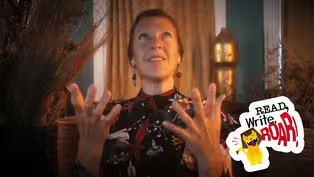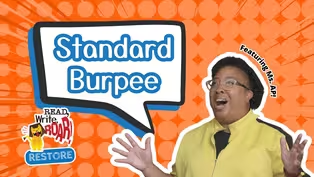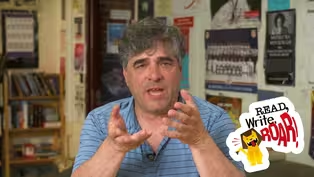Read, Write, ROAR!
International Wildlife Refuge | How to Compare Habitats | Mr. Peterson | Read, Write, ROAR!
Clip: Season 1 Episode 1012 | 6m 29sVideo has Closed Captions
Learn how to conduct research and understand the importance of protecting wildlife.
Join Mr. Peterson on an exciting adventure at the International Wildlife Refuge in Trenton, Michigan. Learn how to conduct research, compare habitats, and understand the importance of protecting wildlife. A great way to start your own nature research project!
Problems playing video? | Closed Captioning Feedback
Problems playing video? | Closed Captioning Feedback
Read, Write, ROAR! is a local public television program presented by Detroit PBS
Read, Write, ROAR!
International Wildlife Refuge | How to Compare Habitats | Mr. Peterson | Read, Write, ROAR!
Clip: Season 1 Episode 1012 | 6m 29sVideo has Closed Captions
Join Mr. Peterson on an exciting adventure at the International Wildlife Refuge in Trenton, Michigan. Learn how to conduct research, compare habitats, and understand the importance of protecting wildlife. A great way to start your own nature research project!
Problems playing video? | Closed Captioning Feedback
How to Watch Read, Write, ROAR!
Read, Write, ROAR! is available to stream on pbs.org and the free PBS App, available on iPhone, Apple TV, Android TV, Android smartphones, Amazon Fire TV, Amazon Fire Tablet, Roku, Samsung Smart TV, and Vizio.
Providing Support for PBS.org
Learn Moreabout PBS online sponsorshiphi explorers it's Mr Peterson check out my gear today where do you think I might be headed if you said I'm headed on an exciting adventure to the Wildlife Refuge you'd be correct we are at a special place called the Detroit River International Wildlife Refuge in Trenton Michigan to help me start a research project that is focused on the question how are Wetland forest and Prairie habitats similar but before we get started on our research I want to talk to the Refuge manager Dan Kennedy about what the Detroit River International Wildlife Refuge is and what makes it unique hi Dan thank you for having us here at the Refuge so what do you do here at the Refuge well first welcome Brian we have three main purposes we do fish and wildlife conservation uh primarily associated with the Detroit River Wetlands uh are our primary focus second we connect people to Nature we have a bunch of community engagement programs where we work with the community to have them appreciate nature and third we're building a program to work with our Canadian Partners on managing a joint resource the Detroit River each country owns a little bit of the Detroit River and so we're trying to work collaboratively with our Canadian Partners that's amazing so what makes this Refuge unique we have quite a few things that make the Refuge unique our big dry is hug Marsh hung buug Marsh is an internationally recognized Wetland and it is the last mile of undeveloped land on the Detroit River on the US side so it's really unique and it's a great resource for bird watchers or kayakers and all that stuff second this used to be a Chrysler plant we're standing on property that used to be a Chrysler plant that was decommissioned in 1990 and then restored to what we see today which then bring brings me to our third unique thing and it's the John D Dingle Visitor Center which we honor the congressman who wouldn't this wouldn't be possible without his efforts thank you Dan for that wonderful information it's really going to help me with my research project you're welcome Brian and good luck with the project now let's get started on our adventure as we gather information around our big question let's take a walk and record or write down some notes about what we observe in each habitat observations are an important way to gather information for our recordings this is a wetland habitat it's a wetland habitat because there's usually water this Wetland habitat is known as humbug Marsh let's make some observations and record them the first thing I noticed is there's some ducks and some egrets I'm also noticing these Turtles up on the log when I look around at the plants I see there's another number of different aquatic plants I see Cattails I see swamp milkweed and I see purple Lo stripe which is an invasive species and if we listen we can hear there's lots of insects these dead trees in the wetlands provide homes for some animals and a great hunting perch for birds like the king fisher all right let's head out to our next habitat this is a forest habitat a forest habitat contains trees and undergrowth like small bushes and other small plants let's observe and see what we can find in this forest habitat this is a Tusk moth caterpillar whose host plant is milkweed this is poke weed you want to be very careful with this plant it's poison ivy this centipede lives on the forest floor up in the trees I see a blue jay these trees are dead but this helps provide a home for some of our forest animals all right let's move on to our final habitat this is a prairie habitat a prairy habitat contains low Ling grasses let's explore and see what we can find here in this Prairie habitat here we see goldfinches and dragonflies we also see common milkweed which is a host plant for one of our favorite butterflies the Monarch here we see some species of bees now that we visited a wetland a forest and a prairie and recorded our observations we can look at what we recorded to help answer our big question how are Wetland forest and Prairie habitat similar we noticed ducks and egrets in the wetlands and blue jays in in the forest and goldfinches in the Prairies these are examples of different birds we found swamp milkweed in the wetlands and we found common milked in both the forest and Prairie habitats we found insects in all three habitats we also found dead trees or dead plants in every habitat these dead trees and plants actually provide home for a lot of animals and even some food so you can see that by taking a walk at the Detroit River International wildlife refuge and recording observations I was able to get a great start on my main research project question how are Wetland forest and Prairie habitats similar observations and recordings are powerful tools writers such as scientific writers use the power of observation and recording to help provide research for their writings now I can use the information from my observations to help me plan the next steps in my research project how could you use observations and recordings to help with your next research project once you have an idea grab some paper get a writing utensil and get out there and explore [Music]
Create an Underground Soundscape | Ms. Audra | Read, Write, ROAR!
Video has Closed Captions
Clip: S1 Ep1012 | 2m 16s | Imagine worms, moles, and even growing plants as we create a soundscape beneath the earth. (2m 16s)
How to Set the Mood in Film | Ms. Kara | Read, Write, ROAR!
Video has Closed Captions
Clip: S1 Ep1012 | 4m 24s | Learn how lighting and visual elements set the mood in film. (4m 24s)
Read, Write, ROAR! Restore - Standard Burpee
Video has Closed Captions
Clip: S1 Ep1012 | 2m 33s | Warm up, add new moves to your burpees, and cool down to stay energized throughout the day. (2m 33s)
Urban Sprawl Haiku: Capturing Nature vs. City Growth in Poetry | Jeff Kass | Read, Write, ROAR!
Video has Closed Captions
Clip: S1 Ep1012 | 5m 53s | Learn how to capture the delicate balance between human-built cities and the natural world. (5m 53s)
Providing Support for PBS.org
Learn Moreabout PBS online sponsorship

- Home and How To

Hit the road in a classic car for a tour through Great Britain with two antiques experts.












Support for PBS provided by:
Read, Write, ROAR! is a local public television program presented by Detroit PBS




